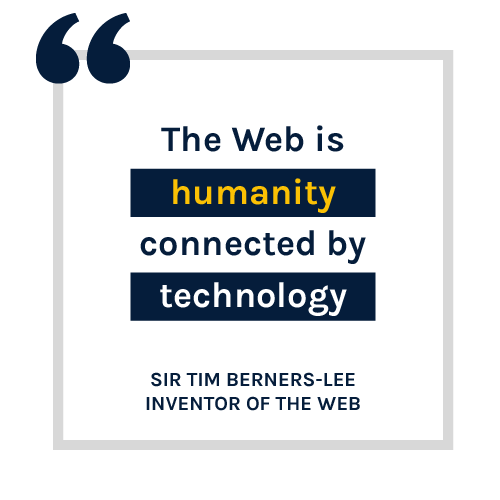News
World Wide Web Consortium celebrates its 25th anniversary
1 October 2019 | Archive
 Today we celebrate the 25th anniversary of the World Wide Web Consortium. Sir Tim Berners-Lee, our Director and the inventor of the World Wide Web, founded the Web Consortium on this day, 1 October, in 1994 to ensure the long-term growth of the Web.
Today we celebrate the 25th anniversary of the World Wide Web Consortium. Sir Tim Berners-Lee, our Director and the inventor of the World Wide Web, founded the Web Consortium on this day, 1 October, in 1994 to ensure the long-term growth of the Web.
Since then, with the help of our Members and our community, we have been proud to work to create a Web that is accessible to all, whatever the hardware, software, network infrastructure, native language, culture, geographical location, or physical or mental ability; a Web which is good for all.
Happy 25th birthday, Web Consortium! 
2019 marks the year when half of the population is now online, the Web turned 30 and the World Wide Web Consortium celebrates its 25th anniversary. The Web has come a long way but myriad opportunities lay ahead. Our society, our world, and the Web face many challenges, and now more than ever the Web Consortium must continue to fulfil our mission, with our global community, to make the web work, for everyone.
I hope you join us in celebrating the 25th anniversary of the Web Consortium and share your birthday wishes and to tell us your #webstories. You may read more in our blog post about some of our achievements, what we do, how we do it and why.
W3C Invites Implementations of Data Catalog Vocabulary (DCAT) - Version 2
3 October 2019 | Archive
The Dataset Exchange Working Group has published a Candidate Recommendation of Data Catalog Vocabulary (DCAT) – Version 2.
DCAT is an RDF vocabulary designed to facilitate interoperability between data catalogs published on the Web. This document defines the schema and provides examples for its use. DCAT enables a publisher to describe datasets and data services in a catalog using a standard model and vocabulary that facilitates the consumption and aggregation of metadata from multiple catalogs. This can increase the discoverability of datasets and data services. It also makes it possible to have a decentralized approach to publishing data catalogs and makes federated search for datasets across catalogs in multiple sites possible using the same query mechanism and structure. Aggregated DCAT metadata can serve as a manifest file as part of the digital preservation process.
Comments are welcome by 31 October 2019.
Call for Review: Web Assembly 1.0 is a W3C Proposed Recommendation
1 October 2019 | Archive
The WebAssembly (WASM) Working Group has published three Proposed Recommendations for Web Assembly 1.0:
- WebAssembly Core Specification
- WebAssembly JavaScript Interface
-
WebAssembly Web API
WebAssembly is a standard, a safe, portable, low-level code format designed for efficient execution and compact representation. These specifications define the language and behavior of the virtual machine as well as a JavaScript API and integration with the broader Web Platform.
Comments are welcome through through 27 October 2019.
